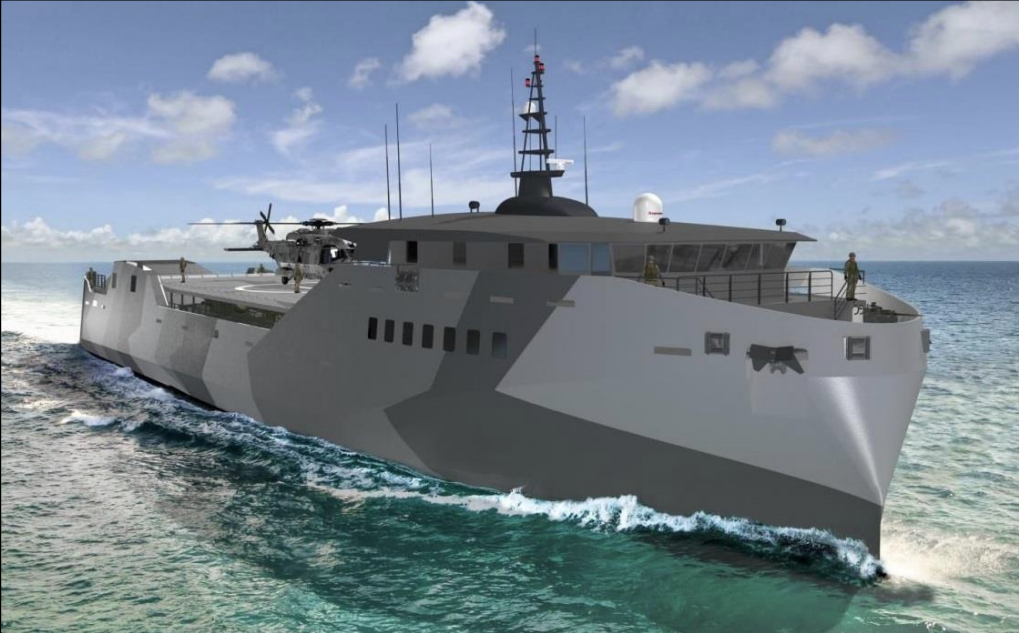 SAN DIEGO – The Marine Corps’ latest requirements call for nine smaller amphibious ships per regiment to shuttle Marines and equipment between islands and shorelines, service officials said today.
SAN DIEGO – The Marine Corps’ latest requirements call for nine smaller amphibious ships per regiment to shuttle Marines and equipment between islands and shorelines, service officials said today.
The service has said for months that it needs 35 Landing Ship Mediums – previously known as the Light Amphibious Warship – for the type of operations it envisions in the Indo-Pacific region. The idea is that the three Marine Littoral Regiments operating in the Indo-Pacific would each have nine LSMs, while leaving room for eight ships that would inevitably get tied up in maintenance periods, according to a new Marine Corps video about requirements.
The Marine Corps came up with this requirement after modeling and simulations, deputy commandant for combat development and integration Lt. Gen. Karsten Heckl said Tuesday at the WEST 2023 conference, co-hosted by the U.S. Naval Institute and AFCEA.
“It doesn’t necessarily need to be a Marine Littoral Regiment,” he said. “So the square footage, the cargo – and that’s where we came up with the requirements – berthing, fuel, all of it,” Heckl said.
The requirements focused on tonnage, square footage for cargo and the need for Marines to move around the region on their own, without the benefit of long runways or ports and piers.
While the program has faced fits and starts over the last few years, Marine Corps officials say the requirements are solid and now it’s time to start building the ship.
“This is all done together. We agree on the requirements. Now we’re trying to move,” Assistant Commandant of the Marine Corps Gen. Eric Smith said during a keynote at the conference.
The ACMC dismissed criticism of the LSM program that argues the platform won’t be survivable, which has been a focal point of the program discourse between the Navy and Marine Corps, USNI News previously reported.
“We’re part of the fleet and if the fleet commander determines that this high-value package of the assets that we just talked about – all the great things: [Navy-Marine Corps Expeditionary Ship Interdiction System], Rogue [fires], [Ground/Air Task-Oriented Radars] – that they need to move from point A to point B, the fleet commander … the 3rd Fleet commander, will apply resources to get that package where it needs to go,” Smith said.
The hope is to start producing the LSMs in the Fiscal Year 2025 to FY 2026 timeline, Smith said. The FY 2023 budget proposal delayed the buy for LAW from FY 2023 to FY 2025.
That delay occurred as the Navy and Marine Corps worked on the requirements for the ship and discussed affordability and survivability. The Marine Corps wants a less expensive ship that can move Marines around so they can set up expeditionary bases on islands and shorelines.
“It has to be affordable because you have to produce it in quantity because that is your organic mobility with limited days of warning, we move … key elements to strategic points, pre-determined points,” Smith said.
While the Marine Corps says it needs 35 LSMs, Chief of Naval Operations Adm. Mike Gilday’s navigation plan called for 18 LAWs, the previous name for the program. Asked about that difference, Heckl said he and deputy chief of naval operations for warfighting requirements and capabilities (OPNAV N9) Vice Adm. Scott Conn crafted requirement language that says the ultimate requirement is 35, but “the initial operational inventory will be 18.”
The LSM program is getting close to the end of the preliminary design review, Heckl told two reporters at the conference.
“You’re going to see a more definitive way forward I think here in the coming months with the timeline,” Heckl said.
In the meantime, the Marine Corps is leasing one stern landing vessel, with the option to lease two more, to test and experiment with the concept. That first vessel went into the water on Monday, Heckl said.
“They’ve put jacks on it – forward, aft. This is a one-of-a-kind ship,” he said.
“We’re on contract for up to 2 more. But these are the things we’re going to learn from and then we’ll iterate on.”
After a contentious budget cycle that began with the Navy and Marine Corps showcasing different priorities in the FY 2023 request, lawmakers in the FY 2023 National Defense Authorization Act provided the Marine Corps Commandant with a direct say in amphibious ship force structure and requirements. While the ships are key to the Marine Corps’ missions, the Navy purchases them out of its shipbuilding account.
“It clearly states from Congress that the role of the commandant of the Marine Corps in defining requirements. That’s a very positive thing. It doesn’t say anything negative about a personal relationship between the [chief of naval operations] and the commandant or the two services are bickering with each other,” Marine Corps Commandant Gen. David Berger said in December when asked about the legislation.





